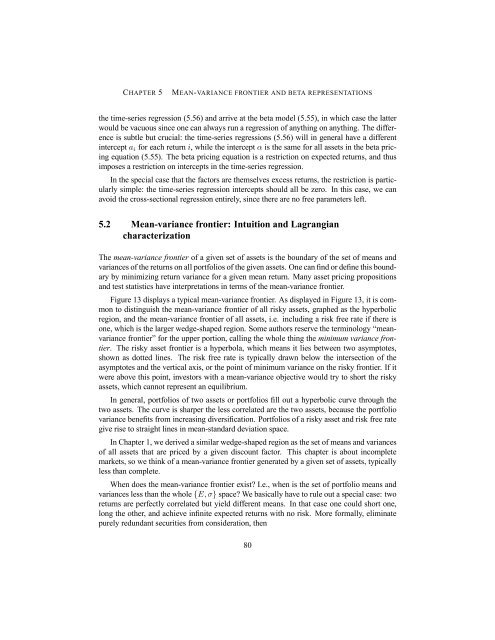Asset Pricing John H. Cochrane June 12, 2000
Asset Pricing John H. Cochrane June 12, 2000
Asset Pricing John H. Cochrane June 12, 2000
Create successful ePaper yourself
Turn your PDF publications into a flip-book with our unique Google optimized e-Paper software.
CHAPTER 5 MEAN-VARIANCE FRONTIER AND BETA REPRESENTATIONS<br />
the time-series regression (5.56) and arrive at the beta model (5.55), in which case the latter<br />
would be vacuous since one can always run a regression of anything on anything. The difference<br />
is subtle but crucial: the time-series regressions (5.56) will in general have a different<br />
intercept ai for each return i, while the intercept α is the same for all assets in the beta pricing<br />
equation (5.55). The beta pricing equation is a restriction on expected returns, and thus<br />
imposes a restriction on intercepts in the time-series regression.<br />
In the special case that the factors are themselves excess returns, the restriction is particularly<br />
simple: the time-series regression intercepts should all be zero. In this case, we can<br />
avoid the cross-sectional regression entirely, since there are no free parameters left.<br />
5.2 Mean-variance frontier: Intuition and Lagrangian<br />
characterization<br />
The mean-variance frontier of a given set of assets is the boundary of the set of means and<br />
variances of the returns on all portfolios of the given assets. One can find or define this boundary<br />
by minimizing return variance for a given mean return. Many asset pricing propositions<br />
and test statistics have interpretations in terms of the mean-variance frontier.<br />
Figure 13 displays a typical mean-variance frontier. As displayed in Figure 13, it is common<br />
to distinguish the mean-variance frontier of all risky assets, graphed as the hyperbolic<br />
region, and the mean-variance frontier of all assets, i.e. including a risk free rate if there is<br />
one, which is the larger wedge-shaped region. Some authors reserve the terminology “meanvariance<br />
frontier” for the upper portion, calling the whole thing the minimum variance frontier.<br />
The risky asset frontier is a hyperbola, which means it lies between two asymptotes,<br />
shown as dotted lines. The risk free rate is typically drawn below the intersection of the<br />
asymptotes and the vertical axis, or the point of minimum variance on the risky frontier. If it<br />
were above this point, investors with a mean-variance objective would try to short the risky<br />
assets, which cannot represent an equilibrium.<br />
In general, portfolios of two assets or portfolios fill out a hyperbolic curve through the<br />
two assets. The curve is sharper the less correlated are the two assets, because the portfolio<br />
variance benefits from increasing diversification. Portfolios of a risky asset and risk free rate<br />
give rise to straight lines in mean-standard deviation space.<br />
In Chapter 1, we derived a similar wedge-shaped region as the set of means and variances<br />
of all assets that are priced by a given discount factor. This chapter is about incomplete<br />
markets, so we think of a mean-variance frontier generated by a given set of assets, typically<br />
less than complete.<br />
When does the mean-variance frontier exist? I.e., when is the set of portfolio means and<br />
variances less than the whole {E,σ} space? We basically have to rule out a special case: two<br />
returns are perfectly correlated but yield different means. In that case one could short one,<br />
long the other, and achieve infinite expected returns with no risk. More formally, eliminate<br />
purely redundant securities from consideration, then<br />
80
















